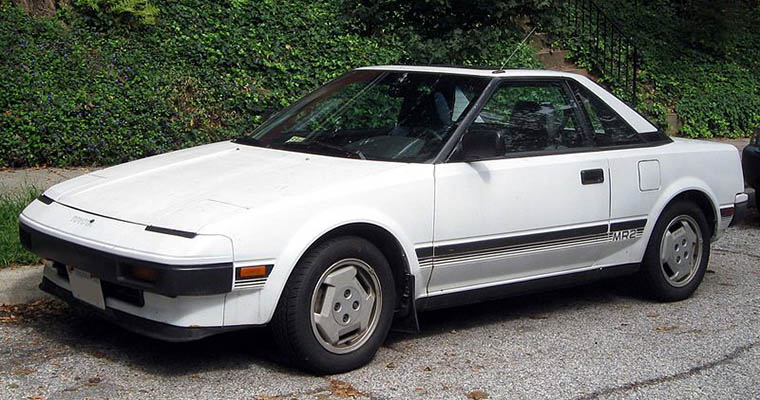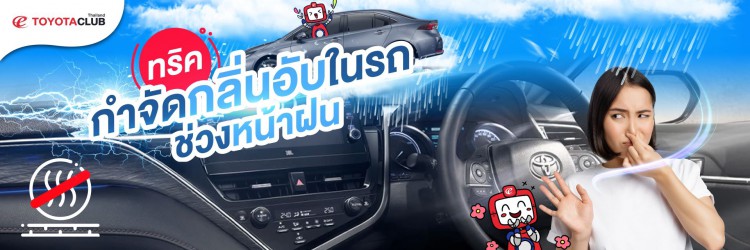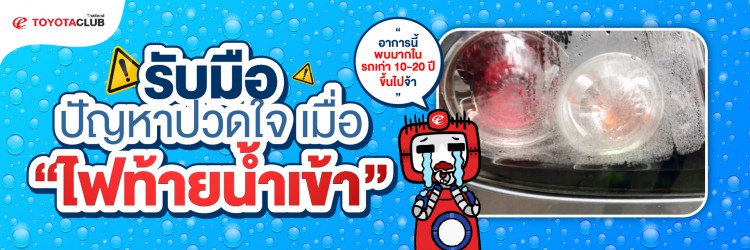

Toyota MR2
The Toyota MR2 is a two-seat, mid-engined, rear-wheel-drive sports car produced by Toyota, from 1984 until July 2007 when production stopped in Japan. There are three different generations of the MR2: 1984–1989, with angular, origami-like lines, 1990–1999, which had styling that some compared to Ferrari sports cars, and 2000–2007, which somewhat resembled the Porsche Boxster.[1] It was designed to be small, with an economical powerplant, but sporty in style and handling. Basic design elements, such as MacPherson strut front and rear suspensions and transverse-mounted inline-four engines, are common to all three generations of MR2, though each generation differs greatly from the next in particulars.
Origins
The MR2's life began in 1976 when Toyota launched a design project with the goal of producing a car which would be enjoyable to drive, yet still provide good fuel economy. Initially the purpose of the project was not to design a sports car. The actual design work began in 1979 when Akio Yoshida from Toyota's testing department started to evaluate different alternatives for engine placement and drive method. The choice was finally made to place the engine transversely in the middle of the car. The result was the first prototype in 1981, dubbed the SA-X. From its base design, the car began evolving into an actual sports car, and further prototypes were tested intensely both in Japan and in California. A significant amount of testing was performed on actual race circuits such as Willow Springs, where former Formula One driver Dan Gurney tested the car.
Toyota made its SV-3 concept car public in October 1983 at the Tokyo Motor Show, gathering a huge amount of publicity both from the press and the audience. The car, scheduled to be launched in the second quarter of 1984 in the Japanese market under the name MR2 (which stands for "mid-engine, rear-wheel drive, two-seater"), was to become the first mass-produced mid-engined car to come from a Japanese manufacturer. In France the name was shortened to MR to avoid the similarity in pronunciation of MR2 with the French words est merdeux, meaning "(it) is shitty".
First generation (W10; 1984–1989)
The small and light MR2 was something no one had expected from Toyota, known for their economical and practical family cars. The two-seat MR2 was definitely not practical as a family car and nor was it intended to be, having been designed instead with style and sport as priorities. The moniker 'Mid-engined Runabout, 2 Seater' was more than a marketing tool - it was the fundamental design philosophy. The folded angular lines evoked origami paper sculpture. Other cars with a similar design concept including the Lancia Beta Montecarlo, Fiat X 1/9 and the exotic Lancia Stratos were all produced in the 70s and early 80s. The most important features of the MR2 were its light body (as low as 2,095 lb (950 kg) in Japan and 2,350 lb (1066 kg) in the US), superior handling and lightly powered, small-displacement engine. The car is often referred to as the AW11, referring to the chassis code of the most common 1.6-litre, A-engined versions.
Some rumors have persisted that the MR2 was designed by Lotus. This is a reference to the Lotus M90 (a.k.a. the X100) project, but this was scrapped after a single prototype was built. This used the same engine and gearbox as the MR2. At the time, Toyota, along with the Chapman family was a major share holder in Lotus, but General Motors later acquired majority control. However, the MR2's suspension and handling were designed by Toyota with the help of Lotus engineer Roger Becker.[4] Toyota's cooperation with Lotus during the prototype phase can be seen in the AW11, and it owes much to Lotus's legendary sports cars of the 1960s and 1970s.
As a power plant, Toyota chose to use the naturally aspirated 4A-GE 1,587 cc straight-4 engine, a dual overhead-cam, four-valve-per-cylinder motor.[5] This engine was also equipped with DENSO electronic port fuel injection and a variable intake geometry ("T-VIS"), giving the engine a maximum power output of 112 hp (84 kW) in the US, 128 hp (95 kW) in the UK, 116 or 124 PS (85 or 91 kW; 114 or 122 hp) in Europe (with or without catalytic converter),[6] 118 hp (88 kW) in Australia and 130 PS (96 kW; 128 hp) in Japan. Japanese models were later downrated to 120 PS (88 kW; 118 hp).[7] The engine had already been introduced earlier on the AE86 Corolla, gathering a lot of positive publicity. A five-speed manual transmission was standard and a four-speed automatic was optional. Road tests delivered 0-60 mph times in the mid- to high-8 second range, and 1/4 mile times in the mid- to high-16 second range, significantly faster than the four-cylinder Pontiac Fiero or Fiat X1/9.[8][9][10] In the home market, the AW10 base model was offered, which used the more economical 1452 cc 3A-U engine rated at 61 kilowatts (82 hp), but it attracted few buyers. In 1987 (1988 for the US market), Toyota introduced a supercharged engine for the MR2. Based on the same block and head, the 4A-GZE was equipped with a small Roots-type supercharger and a Denso intercooler. T-VIS was eliminated and the compression ratio was lowered to 8:1. It produced 145 horsepower (108 kW) and 140 pound-feet (190 N·m) and accelerated the small car from 0 to 100 km/h (0 to 62 mph) in 6.5 to 7.0s.[11][12] The supercharger was belt-driven but actuated by an electromagnetic clutch, so that it would not be driven except when needed, increasing fuel economy. Curb weight increased to as much as 2,494 pounds (1,131 kg) for supercharged models, due to the weight of the supercharger equipment and a new, stronger transmission.[3] A fuel selector switch was also added in some markets, to allow the car to run on regular unleaded if required to. In addition to the new engine, the MR2 SC was also equipped with stiffer springs, and received special "tear-drop" aluminium wheels. The engine cover had two raised vents (only one of which was functional) that visually distinguished it from the normally aspirated models. It was also labeled "Supercharged" on the rear trunk and body mouldings behind both doors. This model was never offered in European or Australian markets, although some cars were privately imported.
Changes by year
- 1986
- T-bar roof option available in Japan
- Revised transmission
- Color-keyed bumpers, side stripes, side skirts available
- Leather interior becomes an option
- Rear anti-roll bar discontinued on North American models
- 1987
- Supercharged model introduced in Japan, offered with four-speed A/T or five-speed M/T
- T-bar roof available in North America and Europe
- Slight unibody changes
- Revised rear suspension and larger brake rotors
- New front lip
- New tail lights for North America
- Naturally aspirated 4A-GE rated at 115 horsepower (86 kW) in America
- Air filter relocated to the trunk
- New center console, steering wheel, gauge cluster markings, and seat colors
- 1988
- Supercharged model available in North America
- 1989
- Incandescent third brake lamp replaced by LED strip integrated into the rear spoiler
- North American supercharged models equipped with rear anti-roll bar
The MR2's legacy
The press received the AW11 with open arms and praised its innovation, great feeling, and responsive engine. American car magazines Road & Track and Car and Driver both chose the MR2 on their lists of ten best cars which included some tough competition, such as the Ferrari Testarossa. The Australian Wheels magazine chose the 1988 MR2 as its favourite sports car. The MR2 was Motor Trend's Import Car of the Year for 1985. (It is worth noting that the MR2 was not eligible for the Car of the Year award, because only vehicles produced in the US were eligible until 1999. The 1985 winner, the Volkswagen GTI, was produced in Westmoreland, Pennsylvania.) The MR2 was also on Car and Driver magazine's Ten Best list for 1986 and 1987. In 2004, Sports Car International ranked the MR2 number eight on the list of Top Sports Cars of the 1980s.
In January 1989 Toyota produced a final run of fully optioned "Super Edition" MR2s. The 'Super Edition' included all the extras of the G-Limited models along with extra features such as a MOMO-commissioned steering wheel and gear knob, Recaro "Milano" seats with matching door panels, and "SUPER EDITION" decals on the rear visor and side stripes). Super Edition cars were sold in special Midnight Blue or white/gold two-tone paint; 270 were produced in each color.
Popular Swaps
The MR2 Mk I still enjoys a fan base to this day. Its twin cam 1600 cc engine has potential, but its power has since been surpassed. Many enthusiasts have decided to turbocharge the engine as an upgrade, while others have decided to bypass this route and simply swap the engine out entirely. Popular swaps include both the fourth-generation 4A-GE twin cam 20-valve silver and black tops, the MR2 Mk II's 3S-GTE and the BEAMS 3S-GE engines, and the supercharged 4A-GZE 16-valve engines typically found in supercharged MR2's. Others even go as far as to change out the 4-cylinder engine for a 6- or 8-cylinder engine, but this requires extensive modifications.
Toyota 222D rally car
While Toyota's front-engine, rear-drive Celica rally cars proved dominant in the African Group B rallies of the 1980s, they were at a disadvantage on the twistier European stages. Thus, in 1985 Toyota Team Europe started a rally project codenamed "222D" based on the MR2, for competition in Group S and potentially Group B as well. Though somewhat similar on the outside, it's clear that it shared very little with the production car. Little is known about this project because it never competed before Group B was canceled in 1986.
During a surprise appearance at the 2006 Goodwood Festival of Speed, Toyota drove and displayed a black 222D. The race-ready car weighed around 750 kilograms (1,700 lb) and its transverse-mounted, four-cylinder, turbocharged engine (what appears to be a 503E race engine, though other prototypes may have used the 4T-GTE) was reported to produce as much as 750 horsepower (560 kW). A V6-powered prototype was also rumored to exist, but has never been seen in public.







